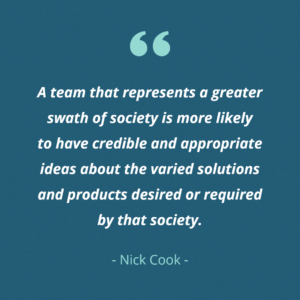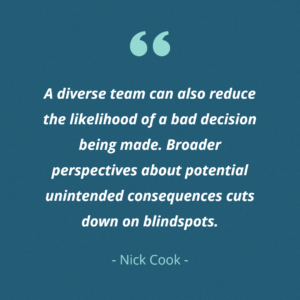By Nick Cook • May 19, 2022
Aside from being good for the soul of a company and benefiting society as a whole, diversity has also been shown to drive innovation in business decisions.
A sizable and credible population of research demonstrates a linkage between how diverse a company’s workforce is and how successful the firm is at developing and implementing new ideas. Of course, processes, structures and technology play a role. But ultimately, the efficiency and effectiveness of innovation efforts rely on the people spearheading them.
Innovation is about how people individually and collectively can conceive of and develop game-changing ideas.

For example, a major research study by Boston Consulting Group in 2018 examined 1,700 entities across the globe and found that companies with more diverse leadership teams reported higher innovation-related revenues. Factoring in diversity in gender, ethnicity, professional background, age and sexual orientation, BCG found that companies with below-average diversity at the leadership level generated on average about a quarter of their revenues (26%) from innovation and change (i.e. new products, services and features launched in the past three years). By comparison, companies with above-average diversity at the leadership level derived almost half (45%) of their revenue from innovation.
So why are diverse teams the engines of innovation?
Diverse and inclusive teams create more unexpected, novel and original ideas. More diverse teams also are more likely to draw inspiration from seemingly unrelated places. Drawing from a more varied and broader range of experiences and knowledge backgrounds allows diverse teams to access more heterogeneous concepts — leading to more innovative ideas.
There are numerous examples of teams drawing inspiration from parallel and unrelated fields, disciplines and experiences. Be it the hospital that improved patient transfers from surgery to intensive care by following certain processes used by Formula One pit crews, or the biotech giant that sought to make MRI scans less stressful for children by playing images and audio stories from Disney movies.

Similar borrowing of ideas is visible in financial services, where firms have taken inspiration from cell phone networks in the development of pay-as-you-go insurance services. One of the major success stories in British innovation, Dyson, was inspired by a sawmill in the development of its vacuum cyclone technology. An engineer was inspired by the shape of the kingfisher bird’s beak when remodeling Japan’s Shinkansen bullet train (which no longer creates a loud boom when traveling through tunnels).
Innovation in the creation or improvement of a product or service line, or indeed across an entire organization will, by definition, involve original thinking. But it is often enabled and inspired by the borrowing of concepts from other organizations and other fields. The more diverse a team is, the more likely and able it is to draw on external sources for inspiration.

Similarly, diverse teams are more likely to conceive of ideas and solutions that meet a diverse customer base’s needs. A team that represents a greater swath of society is more likely to have credible and appropriate ideas about the varied solutions and products desired or required by that society.
Diverse teams are also better at making decisions. Two business school professors in the U.K. wrote in the Harvard Business Review about their experiment to determine how different teams responded to new, uncertain and complex situations. The groups that performed best were more cognitively diverse (with a greater variety in their styles of thinking, problem-solving and mental perspectives) than those that took longer or failed to complete the challenges. Multiple voices and perspectives come together and offer new and fresh perspectives on the tasks at hand. This can lead to higher productivity and creativity.

When teams increase their difference, they increase their chances of selecting an idea that ends up being game-changing. Why? Because diversity of thought stretches a team in ways that may be uncomfortable, yet effective. It helps to raise the ambition level of what a team believes they can accomplish and redefines the parameters that they may otherwise operate within as part of a homogeneous team.
A diverse team can also reduce the likelihood of a bad decision being made. Broader perspectives about potential unintended consequences cuts down on blind spots. Diverse teams are less susceptible to groupthink. Recent research by Bayes Business School in London suggested that greater gender diversity improves risk management culture and lowers the frequency of misconduct fines at European banks.
So, diversity has been shown to strengthen idea creation, decision making and risk management. Research also suggests that valuing diversity and inclusion across the organization will help attract and retain the personnel who can best implement an idea.
Diverse teams looking to execute a business plan are better able to pivot cost-effectively when challenges arise. They have more avenues and choices about how to deliver because they have broader skills and experience and the associated confidence to act that flows from that. This powers their progress.
One reason diverse teams are more effective, researchers point out, is they feel like they have stepped out of their comfort zone when they are not part of a homogeneous group. For example, a 2006 study about mock juries found that white jurors were more careful and deliberate about the case when black people were on the jury. Businesses with homogeneous teams can settle for the status quo, whereas diversity promotes deeper thinking and constructive competition.

Additionally, diverse teams can also navigate organizations more effectively and efficiently. They can leverage their diversity to access and connect with networks and others in the organization, including networks and contacts that would potentially be unavailable to a less diverse team. Teams with a greater diversity of skills are more able to cope with and respond positively to change.
The risks of not valuing diversity in hiring are magnified when one considers data showing that diverse organizations are seen as more attractive to potential new hires, particularly millennials and younger demographics. The talent available to organizations is increasingly becoming a function of how diverse and inclusive they are perceived to be. Once in a diverse organization, individuals also benefit from greater opportunities for learning and development outside of formal educational programs. Professional development and talent within an organization directly relate to how well the company can innovate and carry out the execution of bold ideas.
Diverse organizations (or at least organizations perceived to be diverse) stand more chance of securing scarce talent in a competitive environment and of developing such talent (increasing colleague satisfaction and retention).
Diversity is vital and a key enabler of innovation, but let’s not forget about inclusion.
Businesses cannot assert that the job is done simply if their team is more diverse. Leaders must strive to foster an inclusive culture where people feel safe to make unusual, novel or different suggestions — to say the things that everyone in the room is thinking but no one is saying because they are worried about how it (or they) will be perceived. Diversity creates the potential for different opinions and ideas, but it is inclusion and providing a safe space for those opinions and ideas to flow that allows that potential to be realized.
We are deep into the age of both globalization and digital transformation, making the business sector fertile ground for the rapid exchange of new ideas offered by a professional workforce that is more diverse, younger and technologically savvy than ever before. The companies that will lead the innovation pack are those that welcome — rather than dismiss — the experimentation, novel thinking, inclusive cultures and dynamism that come with a more diverse cohort of idea leaders.

Stay informed by joining our mailing list